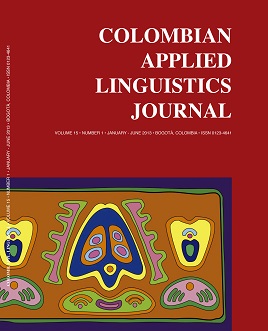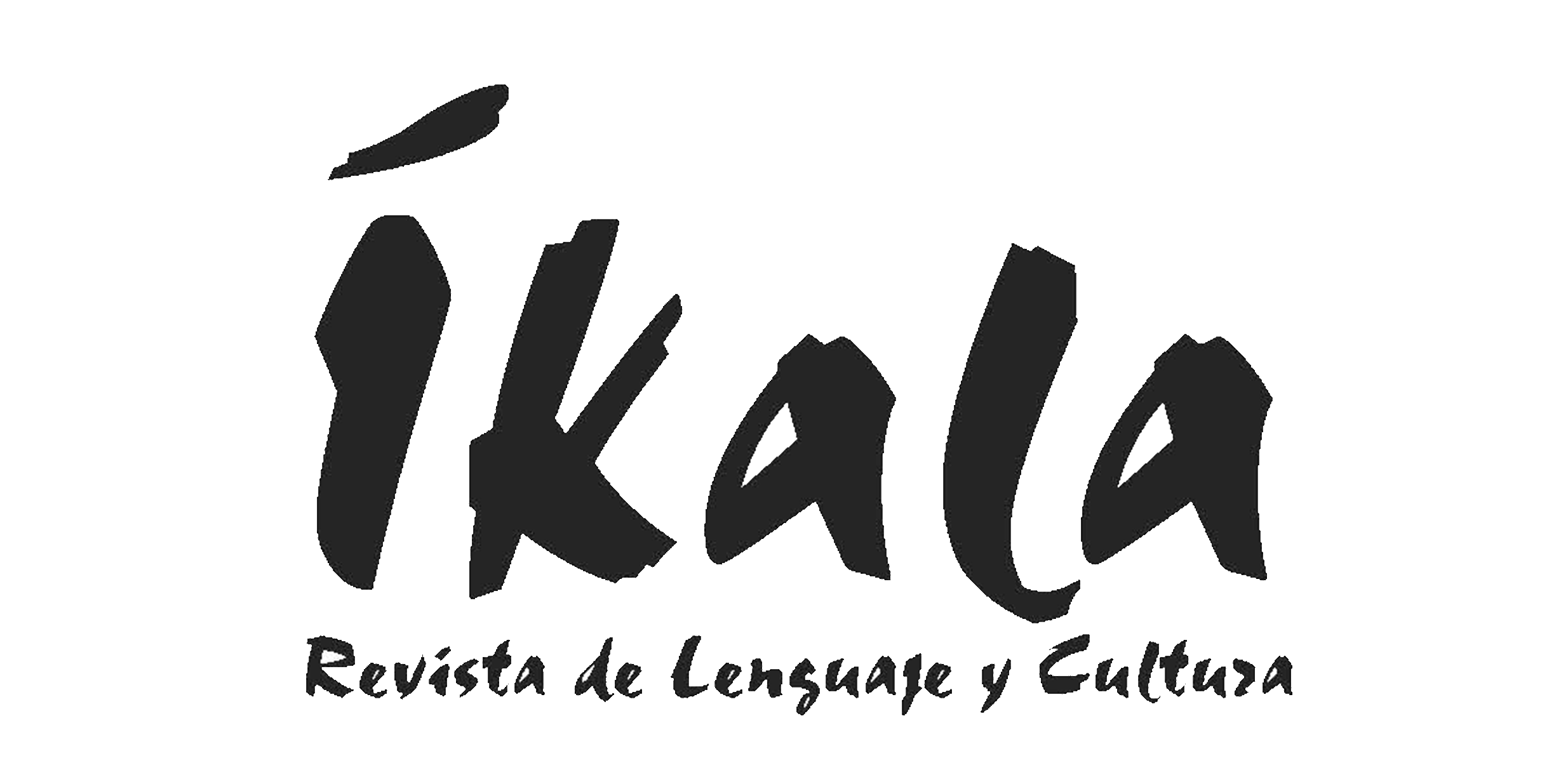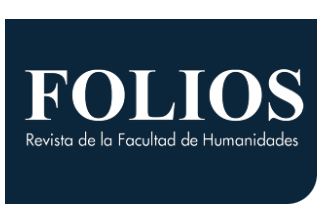DOI:
https://doi.org/10.14483/udistrital.jour.calj.2013.1.a01Published:
2013-01-01Issue:
Vol 15, No 1 (2013) January-JuneSection:
Research ArticlesFrom contrastive rhetoric towards perceptions of identity: written academic English in Central Mexico
De la retórica del contraste a las percepciones de identidad: escritura académica en inglés en México central.
Keywords:
lectoescritura, percepción de identidad discursiva, redacción académica (es).Keywords:
academic writing, EFL literacy, perception of discoursal identity (en).Abstract (en)
This research looks at two students at the end of a four year period in academic writing as a second language using open interviews and textual analysis of academic papers. While the initial focus of the research was on the development of rhetorical features in academic texts, issues more oriented to identity construction emerged through the data analysis, implying that long term academic writing in a second language may be more akin to literacy development. The results seem to show that while the participants express a strong identity with English as writers, the actual writing is more in tune with conventions of Spanish. This suggests an apparent conflict of English as a tool for writing and Spanish as the language of the individual.
Abstract (es)
Esta investigación estudia la redacción académica en una lengua extranjera de dos alumnos en un período de cuatro años, utilizando entrevistas abiertas y análisis de ensayos académicos. Aunque el enfoque inicial de la investigación era del desarrollo de herramientas retóricas en textos académicos, algunos problemas relacionados con la construcción identitaria emergieron a través del análisis de los datos, lo cual podría indicar que el desarrollo a largo plazo de redacción académica en una segunda lengua puede estar más vinculado con lecto-escritura. Los resultados parecen mostrar que mientras los participantes expresan una fuerte identificación con el inglés, su escritura está más en sintonía con las convenciones de español. Esto sugiere un aparente conflicto con el inglés como herramienta de redacción y el español como lengua de expresión del individuo.
References
Abasi, A. (2012). The pedagogical value of intercultural
rhetoric: A report from a Persian-as-a-foreignlanguage
classroom. Journal of Second Language
Writing, 21 (3), 195-220.
Abbott, D. (1996). Rhetoric in the New World: Rhetorical
Theory and Practice in Colonial Spanish America.
Columbia, South Carolina: University of South
Carolina Press.
Atkinson, D. (2004). Contrasting rhetorics/contrasting
cultures: Why contrastive rhetoric needs a better
conceptualization of culture. Journal of English for
Academic Purposes, 3(4), 277-289.
Allison, D. (2001). Meaning in the mind? Making sense
of comments in questionnaires and interviews. The
English Teacher, 4 (3), 1-15.
Brookes, A. & Grundy, P. (1998). Beginning to Write.
Cambridge: Cambridge University Press.
Byrne, D. (1988). Teaching Writing Skills. London:
Longman.
Canagarajah, A.S. (2002). Critical Academic Writing. Ann
Arbor: The University of Michigan Press.
Casanave, C. (2004). Controversies in Second Language
Writing: Dilemmas and Decisions in Research and
Instruction. Ann Arbor: The University of Michigan
Press.
Cheng, R. (2013). A non-native student’s experience
on collaborating with native speakers in academic
literacy development: A socio-political perspective.
Journal of English for Academic Purposes, 12,
-22.
Clark, R. (1992). Principles and practice of CLA in the
classroom. In N. Fairclough (Ed.) Critical Language
Awareness. London: Longman.
Clark, R. (1993). Developing practices of resistance:
Critical reading for students of politics. In D. Graddol
et al. (Eds.) Language and Culture. Clevedon: Multilingual
Matters.
Clark, R. and Ivanič, R. (1997). The Politics of Writing.
London: Routledge.
Clyne, M. (1987). Cultural differences in the organization
of academic texts: English and German. Journal of
Pragmatics, 11, 211-247.
Connor, U. (1996). Contrastive Rhetoric: Cross-cultural
Aspects of Second Language Writing. New York:
Cambridge University Press
Connor, U. (2002). New direction in contrastive rhetoric.
TESOL Quarterly, 36(4), 493-510.
Crawford, T. (2007).Some historical and academic considerations
for the teaching of second language
writing in English in Mexico, MEXTESOL Journal,
(1), pp. 75-90.
Crawford, T. (2010). ESL Writing in the University of
Guanajuato: The Struggle to Enter a Discourse Community,
Guanajuato: University of Guanajuato Press.
Denzin, N. & Lincoln, Y. (2005). (Eds.). The Sage Handbook
of Qualitative Research (3rd ed.). London:
SAGE Publications.
Flower, L. & Hayes, J.R. (1981). A cognitive process
theory of writing. College Composition and Communication,
(4), 365-387.
Gaskell, G. (2000). Individual and group interviewing.
In Bauer, M. & G. Gaskell (Eds.), Qualitative Researching
with Text, Image and Sound: A Practical
Handbook. (pp. 38-56). London: SAGE Publications
Goodson, I. (1997). Representing teachers.Teachers and
Teacher Education, 13, 111-117.
Gray, J. (2002). The global coursebook in English
Language Teaching in Block and Cameron (eds.)
Globalization and Language Teaching. New York:
Routledge.
Hairstone, M. (1982). The winds of change: Thomas Kuhn
and the revolution in the teaching of writing. College
Composition and Communication, 33(1), 76-88.
Halliday, M.A.K. (1985). Spoken and Written Language.
Oxford: Oxford University Press.
Hammersley, M. & Atkinson, P. (1995). Ethnography:
Principle in practice. London: Tavistock.
Henry, J. (2000). Writing Workplace Cultures: An Archaeology
of Professional Writing. United States of
America: Southern Illinois University Press.
Howarth, D. (2000). Discourse. Buckingham: Open
University Press.
Ivanič, R. (1998). Writing and Identity: The discoursal
construction of identity in academic writing. Philadelphia:
John Benjamins Publishing Company.
Johns, A. (1995). Genre and pedagogical purposes.
Journal of Second Language Writing, 4(2), 181-190.
Johns, A. (1997). Text, Role, and Context: Developing
Academic Literacies. London: Cambridge University
Press.
Kaplan, R.B. (1967). Contrastive rhetoric and the teaching
of composition. TESOL Quarterly, 1(4), 10-16.
Kubota, R. & Lehner, A. (2004). Toward critical contrastive
rhetoric. Journal of Second Language Writing,13,
-27.
Liebman, J. (1988). Contrastive rhetoric: Students as
ethnographers. Journal of Basic Writing, 7(2), 6-27.
Mahfoudhi, A. (2001). ESL/EFL Writing: Towards an
Integrative Approach. Indian Journal of Applied
Linguistics 27(2), 149-166.
Matsuda, P. (1997). Contrastive rhetoric in context: A
dynamic model of L2 writing. Journal of Second
language Writing. 6(1) 45-60.
Montaño-Harmon, M. (1991). Discourse features of written
Mexican Spanish: Current research in contrastive
rhetoric and its implications. Hispania, 74, 417-425.
Panetta, C. G. (2001). Understanding cultural differences
in the rhetoric and composition classroom: Contrastive
rhetoric as answer to ESL dilemmas. In C.G.
Panetta (Ed.) Contrastive Rhetoric Revisited and Redefined,
pp.3-13, Mahwah, NJ.: Lawrence Erlbaum.
Pennycook, A. (2001). Critical Applied Linguistics: A Critical
Introduction. Mahwah, NJ: Lawrence Erlbaum
Associates, Publishers.
Purves, A. (Ed.) (1988). Writing across Languages and
Cultures: Issues in Contrastive Rhetoric. Newbury
Park, CA: Sage Publications.
Raimes, A. (1983). Techniques in Teaching Writing.
Oxford: Oxford University Press.
Raimes, A. (1991). Out of the woods: Emerging traditions
in the teaching of writing. TESOL Quarterly, 25(3),
-430.
Ramanathan, V. & Atkinson, D. (1999). Individualism, academic
writing, and ESL writers. Journal of Second
Language Writing, 8, 45-75.
Rapley, T. (2007). Interviews. In Seale, C., Gobo, G.,
Gubrium, J. F. & Silverman, D. (Eds.), Qualitative
research practice. (pp. 15-33). London: SAGE Publications.
Richards, J. & Rodgers, T. (1986). Approaches and
Methods in Language Teaching. Cambridge: Cambridge
University Press.
Richards, J. & Schmidt, R. (1993). Language and Communication.
New York: Longman.
Rosenthal, G. (2007).Biographical research. In Seale,
C., Gobo, G., Gubrium, J. F. & Silverman, D.
(Eds.).Qualitative Research Practice. (pp. 48-64).
London: SAGE Publications.
Ruanni, T. & Tupas, F. (2006). Why do my students write
the way they write?: The problem of culture in the
teaching of professional communication. Singapore
Tertiary English Teachers Society (STETS), 1-10.
Russell, D.R. (1991). Writing in Academic Disciplines,
-1990: A Curricular History. Carbondale:
Southern Illinois University Press.
Silva, T. (1990). Second language composition instruction:
Developments, issues, and directions in ESL
in Barbara Kroll (Ed.) Second Language Writing:
Research Insights for the Classroom, New York:
Cambridge University Press.
Silveira R. (1999). The relationship between writing
instruction and EFL students’ revision processes.
Linguagem&Ensino, 2(2), 109-127.
Smitherman, G. & Villanueva, V. (Eds.) (2003). Language
Diversity in the Classroom: from Intention to Practice.
Carbondale: Southern Illinois University Press.
Soler-Monreal, C., Carbonell-Olivares M., & Gil-Salom L.
(2011). A contrastive study of the rhetorical organisation
of English and Spanish PhD thesis introductions.
English for Specific Purposes 30, 4–17.
Swales, J. (1990).Genre Analysis. Cambridge: Cambridge
University Press.
How to Cite
APA
ACM
ACS
ABNT
Chicago
Harvard
IEEE
MLA
Turabian
Vancouver
Download Citation
Metrics
License
This work is licensed under a Creative Commons Attribution-NonCommercial-NoDerivatives 4.0 International License.
Attribution — You must give appropriate credit, provide a link to the license, and indicate if changes were made. You may do so in any reasonable manner, but not in any way that suggests the licensor endorses you or your use.
NonCommercial — You may not use the material for commercial purposes.
NoDerivatives — If you remix, transform, or build upon the material, you may not distribute the modified material.
The journal allow the author(s) to hold the copyright without restrictions. Also, The Colombian Apllied Linguistics Journal will allow the author(s) to retain publishing rights without restrictions.









